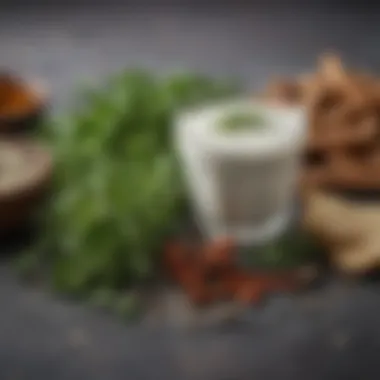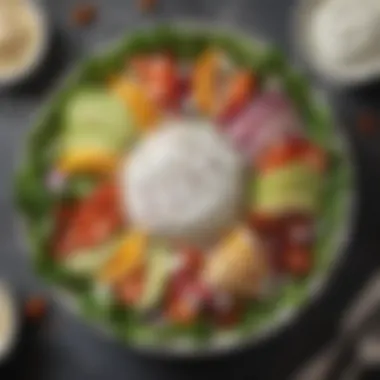Best Buttermilk Ranch Dressing: A Comprehensive Guide


Intro
Buttermilk ranch dressing is a staple in many kitchens, known for its rich flavor and versatility. It pairs well with salads, vegetables, and even as a dip for various snacks. Its creamy texture and a balance of tanginess make it an appealing choice for those who enjoy robust flavors. Understanding how to prepare this dressing involves more than just tossing ingredients together; it requires knowledge of key components, techniques, and variations that can elevate your culinary creations. This article serves as a guide for both seasoned chefs and home cooks alike, aiming to help you master the art of buttermilk ranch dressing.
Recipe Overview
Buttermilk ranch dressing is a delightful fusion of flavors, with a smooth and creamy consistency. It has roots in American culinary tradition and reflects a combination of herbs and spices. The significance of this dressing stretches beyond mere taste; it embodies a sense of comfort food.
Brief description of the dish
This dressing is incomparable when it comes to enhancing the flavor profile of salads or marinating meats. With its origins linked to ranch-style cuisine, buttermilk ranch dressing provides a sense of authenticity and satisfaction.
Ingredients list
To prepare the best buttermilk ranch dressing, you will need:
- 1 cup buttermilk
- 1/2 cup mayonnaise
- 1/2 cup sour cream
- 1 tablespoon fresh dill, chopped
- 1 tablespoon fresh chives, chopped
- 1 tablespoon fresh parsley, chopped
- 1 clove garlic, minced
- 1 teaspoon onion powder
- Salt and pepper to taste
Step-by-Step Cooking Instructions
Creating buttermilk ranch dressing is a straightforward yet satisfying task. Follow the steps below to craft a dressing that delights.
- Combine the Base Ingredients
In a mixing bowl, combine the buttermilk, mayonnaise, and sour cream. Whisk them together until the mixture is smooth and creamy. - Add Fresh Herbs
Incorporate the chopped dill, chives, and parsley into the mixture. These herbs are vital in crafting the signature flavor of ranch dressing. - Incorporate Aromatics
Mix in the minced garlic and onion powder. These elements will add depth and complexity to the dressing. - Season to Taste
Finally, season the dressing with salt and pepper. Taste and adjust the seasoning as per your preference. - Chill Before Serving
For the best flavor, refrigerate the dressing for at least 30 minutes before serving. This allows the flavors to meld beautifully.
Tip: Ensure that there are no lumps for a premium texture.
Useful Tips for Each Step
- When selecting buttermilk, opt for a fresh product to ensure the best taste.
- Fresh herbs are always recommended for this dressing; dried herbs can alter the flavor significantly.
- If you prefer a looser dressing, you may add milk or additional buttermilk until the desired consistency is reached.
This comprehensive guide serves as an introduction into the world of buttermilk ranch dressing, but it can also be the start of your culinary explorations. With each step you take, remember the beauty of simplicity in cooking meets the complexity of flavor.
Foreword to Buttermilk Ranch Dressing
The compelling appeal of buttermilk ranch dressing transcends mere flavor; it embraces a rich cultural history and culinary versatility. This dressing is an quintessential component in American cuisine, used in various dishes ranging from salads to dips. By examining its background, we can better appreciate the nuances of ingredients and preparation techniques involved in making an exceptional ranch dressing. Understanding buttermilk ranch dressing helps us connect with its roots, enhancing our culinary experience.
Historical Context
Buttermilk ranch dressing has roots that can be traced back to the ranching communities of the American West. It is believed to have originated in the 1950s, when ranchers created a dressing to use with fresh vegetables. The simplicity and flavor made it an instant favorite among households. Over time, buttermilk ranch dressing has evolved, becoming a staple in restaurants, homes, and picnics as a versatile condiment. Today, it has transcended its humble beginnings, finding a place on dining tables across the globe.
Culinary Significance
The significance of buttermilk ranch dressing in culinary arts cannot be understated. It serves not only as a dressing but also as a dip and a flavor enhancer for various dishes. The unique combination of buttermilk, mayonnaise, and herbs creates a balance of creaminess and acidity, making it versatile for many recipes. Its appeal lies in its ability to complement a wide array of ingredients, from crispy vegetables to savory meats. There is widespread appreciation for how buttermilk ranch dressing elevates the flavors of an otherwise mundane dish, turning it into a gourmet experience.
Key Ingredients
The composition of buttermilk ranch dressing plays a pivotal role in its flavor profile and texture. Each ingredient not only serves a distinct purpose but also contributes to the overall complexity of taste that makes ranch dressing a popular choice for various culinary applications. Understanding the importance of each component can enhance the quality of the dressing, ensuring it meets the expectations of food enthusiasts.
Buttermilk: The Base
Buttermilk is a fundamental element in ranch dressing. It provides a tangy flavor that forms the backbone of this dressing. The acidity helps to balance the richness of the other components, notably mayonnaise. Furthermore, buttermilk lends a creamy texture without being overly heavy, making the dressing suitable for salads or as a dip. It is worth noting that buttermilk can be easily made at home by mixing milk with vinegar or lemon juice, though store-bought options often offer consistency and convenience for the home cook.


Mayonnaise: Texture and Creaminess
Mayonnaise acts as a thickening agent in ranch dressing, bringing a smooth and velvety consistency. The emulsion of oil, egg yolks, and acid in mayonnaise introduces a rich creaminess that complements buttermilk's tang. This unique combination creates a mouthfeel that is both indulgent and satisfying. When selecting mayonnaise, it is advisable to choose a high-quality product, as this can significantly elevate the overall taste of the dressing. Homemade mayonnaise might offer a fresh flavor, but store-bought versions provide reliability and ease of use.
Herbs and Spices
Fresh vs. Dried
The choice between fresh and dried herbs is a significant consideration when preparing buttermilk ranch dressing. Fresh herbs, such as dill and chives, impart a vibrant flavor and aroma, contributing a layered complexity to the dressing. They are more potent and provide a lively freshness. However, they may not be as easily accessible year-round, and their flavors can diminish over time.
On the other hand, dried herbs offer convenience and a longer shelf life. They are often more concentrated in flavor, which can provide a strong impact in smaller quantities. The choice between fresh and dried ultimately depends on availability and personal preference, both of which can significantly influence the final taste of the dressing.
Common Selections
Common herb selections in buttermilk ranch dressing include dill, parsley, and chives. These herbs not only enhance flavor but also contribute to the aesthetic appeal of the dressing. Dill, with its distinct taste, adds an earthy sweetness, while parsley provides a fresh, green note. Chives offer a mild onion flavor which rounds out the mix. Each of these herbs can be adjusted to taste, allowing the home cook to tailor the dressing to their liking.
Garlic and Onion: Flavor Enhancers
The inclusion of garlic and onion in ranch dressing cannot be overstated. These ingredients serve as flavor enhancers, injecting depth and complexity into the dressing. Fresh garlic adds pungency, while onion brings sweetness and warmth. Both can be adjusted based on individual taste preferences, making them versatile components. Whether using powdered versions or fresh, these flavor enhancers create a well-rounded dressing that elevates any dish.
Vinegar: Adding Tang
Vinegar is another crucial ingredient in buttermilk ranch dressing, providing a sharp tang that balances the richness of the mayonnaise and buttermilk. Common choices include apple cider and white vinegar, each offering unique flavor profiles. Apple cider vinegar gives a slightly fruity note, whereas white vinegar provides a more straightforward acidity. The right vinegar choice can enhance the dressing's overall brightness and freshness, making it more enjoyable.
Preparation Techniques
Preparation techniques play a crucial role in achieving the perfect buttermilk ranch dressing. Understanding how to properly combine, blend, and adjust flavors can significantly enhance the overall quality of the dressing. Each technique contributes to a final product that balances texture, taste, and aroma.
Combining Ingredients
Combining ingredients is the first step in making buttermilk ranch dressing. It involves selecting and mixing the key components: buttermilk, mayonnaise, herbs, garlic, and vinegar. Importance lies in balance. Each ingredient has its own unique flavor profile. It is essential to add ingredients in the correct order to ensure that the flavors meld properly. Start with the buttermilk and mayonnaise as they create the base of the dressing. Then, incorporate the herbs and seasonings slowly. This method prevents overwhelming the base flavors.
Consider this an art. If you rush, you might miss the right balance. Ensure that the herbs are evenly distributed throughout for a consistent taste with each scoop.
Blending for Consistency
Blending is where texture comes into play. After combining the ingredients, it's vital to blend them until smooth. A food processor or immersion blender can be useful here. The goal is to achieve a creamy consistency without lumps. If you prefer a chunkier dressing, blend just enough to incorporate ingredients without turning them to a puree.
The blending stage also impacts flavor integration. A well-blended dressing will taste better than one that is merely mixed. Achieving the right consistency is about adjusting until you find the perfect smoothness.
Tasting and Adjusting Flavors
Tasting and adjusting flavors is an essential final step in the process. It allows for personal preference to dictate the final outcome. After blending, take a moment to taste the dressing. This is where you can really hone in on what is needed. If the dressing tastes too tangy, adding a little more mayonnaise can help balance it.
Consider the element of salt as well. Sometimes, just a pinch can bring out the flavors in the dressing. Remember to adjust slowly, tasting after each addition until it meets your desired flavor profile.
"The beauty of ranch dressing lies in its versatility, making it a canvas for countless flavor adjustments."
By focusing on these preparation techniques, you ensure that your buttermilk ranch dressing is not just another condiment but a delicious addition suitable for numerous dishes.
Variations of Buttermilk Ranch Dressing


Variations of buttermilk ranch dressing are significant as they highlight the adaptability of this classic condiment. While traditional ranch dressing is always appreciated, these variations allow cooks and food enthusiasts to explore different flavor profiles, meet dietary preferences, and add new dimensions to dishes. Each variation can enhance salads, dips, or main courses, making it an essential part of culinary creativity.
Spicy Ranch Dressing
Spicy ranch dressing introduces a kick to the original recipe. This variation typically involves adding hot sauce, such as Frank's RedHot or sriracha, to the base mix of buttermilk and mayonnaise. The result is a zesty dressing that complements a wide range of foods, particularly chicken wings, grilled veggies, or as a dip for chips. The balance of creaminess and heat can appeal to those who enjoy bold flavors.
- Preparation: Start with the basic ranch dressing recipe. Gradually mix in your preferred hot sauce. Adjust according to the desired spice level.
- Uses: Perfect for spicing up appetizers or salads, and it can also serve as a marinade for meats.
Herb-Infused Variants
Herb-infused variants elevate the taste of buttermilk ranch dressing by incorporating fresh or dried herbs. Common selections include dill, parsley, chives, or basil. Fresh herbs provide a bright flavor, while dried ones can offer a more concentrated essence. This variation respects the classic roots of ranch while allowing for personal touch.
- Preparation: Chop fresh herbs finely or measure dried herbs. Mix them into the basic dressing, allowing the flavors to meld.
Vegan Alternatives
Vegan alternatives for buttermilk ranch dressing cater to those who avoid animal products. This variation typically replaces buttermilk with plant-based substitutes like almond milk or soy yogurt. For richness, tahini or avocado can be added, along with nutritional yeast for a cheesy flavor.
- Preparation: Blend plant-based ingredients with the typical ranch seasonings. Experiment with adjustments to achieve the desired taste and consistency.
- Serving Suggestions: This vegan ranch can serve as a salad dressing or dip for fresh vegetables, making it suitable for gatherings where various dietary needs exist.
Gluten-Free Options
For those following a gluten-free diet, ensuring the ranch dressing is suitable is crucial. Most traditional ingredients are naturally gluten-free, but it is essential to check labels on packaged items like mayonnaise or sour cream. One can easily adapt the dressing without removing the delicious taste or texture.
- Preparation: Stick to basic ingredients and ensure any added components, like spicy elements or herbs, are gluten-free.
- Benefits: This accommodation allows everyone to enjoy the dressing without health concerns, making it a versatile choice for gatherings and meals.
Adaptability is key. Each variation highlights the versatility of buttermilk ranch dressing, ensuring it can cater to diverse tastes and dietary needs.
Serving Suggestions
Serving suggestions for buttermilk ranch dressing play a crucial role in enhancing the overall dining experience. This dressing is versatile and can complement a wide array of dishes. Understanding how to effectively pair it with various foods not only maximizes flavor but also elevates the meals, making them more enjoyable. From salads to snacks, the right accompaniments can highlight the creamy texture and savory flavor profile of the dressing, making it a staple in many kitchens.
Accompaniments for Salads
Buttermilk ranch dressing is an excellent option for salads. Its rich flavor can elevate simple greens to something memorable. Leafy salads, such as Caesar or garden varieties, benefit greatly from the addition of this dressing.
- Flavor Balance: The dressing can balance the bitterness of certain greens. This makes it particularly suitable for salads incorporating arugula or radicchio.
- Texture Contrast: The creamy texture of ranch pairs well with crisp vegetables. This creates a satisfying contrast in every bite.
Many home cooks choose to drizzle buttermilk ranch over their salads. This can add moisture and flavor, turning a basic dish into a culinary delight. Experimenting with different salad ingredients is encouraged.
Pairing with Vegetables and Dips
Pairing buttermilk ranch dressing with vegetables is another popular way to enjoy it. Fresh vegetables such as carrots, celery, and bell peppers are ideal dippers.
- Healthy Snack: Serving it with raw veggies is a nutritious choice. It encourages healthier eating habits while making snacks enjoyable.
- Flavor Enhancement: The dressing serves as a flavor enhancer. The tanginess complements the natural sweetness of vegetables.
You may consider serving it at gatherings. A platter of assorted vegetables with buttermilk ranch as a dip can impress guests. It provides an engaging and interactive snack
Incorporating into Sandwiches and Wraps
Using buttermilk ranch dressing in sandwiches and wraps adds moisture and flavor. It works particularly well as a spread or drizzle on various types of sandwiches.


- Protein Addition: Whether it’s chicken, turkey, or roasted veggies, this dressing can enhance flavors. It helps to bind together ingredients within the sandwich.
- Versatility: Ranch dressing adapts well to wraps. Its creamy texture prevents the wrap from being too dry.
The dressing adds a richness that can elevate basic sandwiches into gourmet meals. The ability to customize sandwiches with various fillings makes this approach exciting.
Utilizing in Marinades and Sauces
Buttermilk ranch dressing can also serve as an effective marinade or component in sauces. A marinade with ranch can infuse meats with flavor before grilling or roasting.
- Infusion of Flavor: The various herbs within the dressing penetrate the meat, resulting in deeper flavors.
- Moisture Retention: By marinating meats, the dressing helps retain moisture, ensuring tenderness.
Furthermore, ranch dressing can be blended with other ingredients to create flavorful sauces. This enhances dishes such as grilled chicken or roasted vegetables. With some creativity, it can transform meals and offer a unique twist on traditional flavors.
In essence, buttermilk ranch dressing is not just a condiment; it's an excellent culinary element that enhances many dishes, making it a valuable addition to your kitchen repertoire.
Storage and Shelf Life
Understanding the storage and shelf life of buttermilk ranch dressing is essential for anyone who wishes to enjoy this creamy condiment at its best. Proper storage ensures that the dressing maintains its quality, flavor, and overall safety for consumption. Various factors influence how long your homemade ranch dressing can last. Being aware of these can save you from waste and disappointment.
Refrigeration is one of the most vital aspects of storage for buttermilk ranch dressing. Knowing how to store it not only prolongs freshness but also preserves its unique taste profile.
Refrigeration Guidelines
Once prepared, buttermilk ranch dressing should always be stored in the refrigerator. Ensure the dressing is kept in an airtight container. Glass jars or BPA-free plastic containers work well for this purpose. The theory is that reducing exposure to air helps maintain the dressing's flavor and texture.
Aim to consume homemade ranch dressing within one week for best quality. Some store-bought versions may contain preservatives, which can extend shelf life beyond this point. Always check the label for specific recommendations.
- Always Label Containers: Writing the date of preparation on the container can help you track freshness.
- Keep It Cold: Ensure your refrigerator temperature is below 40°F (4°C) to prevent bacterial growth.
- Avoid Cross-Contamination: Never dip food directly into the dressing jar. Use clean utensils each time you serve.
Signs of Spoilage
Like any dairy product, buttermilk ranch dressing can spoil over time. Identifying spoilage is crucial. Look for these signs to avoid consuming unsafe products:
- Off Odor: If the ranch dressing develops an unpleasant or sour smell, this is a warning sign.
- Texture Changes: Separation of ingredients or a watery appearance can indicate spoilage.
- Mold Growth: Any sign of mold—whether on the surface or submerged—means you should discard the dressing immediately.
- Unusual Taste: If you notice a change in flavor when tasting the dressing, it's better to throw it out.
Always prioritize food safety. When in doubt, throw it out to avoid foodborne illnesses.
By following these guidelines, you can ensure that your buttermilk ranch dressing not only tastes great but is also safe to consume.
Finale
The conclusion of this article on buttermilk ranch dressing serves as a pivotal element in summarizing the essence of the topic. It emphasizes the significance of understanding not only the recipe but also the cultural and culinary impact of this dressing. Buttermilk ranch dressing is more than just a condiment; it is an accompaniment that elevates the dining experience.
Embracing this dressing allows consumers to explore various textures and flavors, providing flexibility in meal options. The right preparation techniques and quality ingredients can make a substantial difference in taste. This article outlines how buttermilk ranch dressing is a unifying element in dishes ranging from salads to sandwiches. The versatility it offers should not be overlooked.
Moreover, we recognize that the significance of this dressing stretches beyond personal preferences. It represents a blend of traditional practices and modern culinary trends, tapping into a shared appreciation for comfort food and creativity in the kitchen.
Highlights and Takeaways
Before concluding, it is essential to distill the key points discussed throughout the article. Here are some highlights to consider:
- Key Ingredients: The core components— buttermilk, mayonnaise, herbs, spices, garlic, and vinegar—are foundational to achieving the desired flavor and texture. Understanding their roles enhances the overall quality of the dressing.
- Preparation Techniques: Precise techniques for combining, blending, and tasting ensure an ideal consistency and flavor balance. These steps are crucial for anyone serious about crafting their dressing.
- Variations: Exciting variations, such as spicy or herb-infused ranch, cater to diverse taste preferences and dietary needs, such as vegan or gluten-free options.
- Serving Suggestions: The article presents numerous ideas on how to incorporate ranch dressing into meals, highlighting its adaptability across different cuisines.
By articulating these highlights, the reader gains a clear understanding of what constitutes an excellent buttermilk ranch dressing.
Final Thoughts
The exploration of buttermilk ranch dressing ultimately showcases the beauty of simple ingredients coming together to form a complex flavor profile. Food lovers can enjoy a rewarding journey in making this dressing.
Investing time in perfecting homemade buttermilk ranch dressing translates into superior taste compared to store-bought versions. The satisfaction derived from creating one's version of a beloved condiment cannot be overstated.







